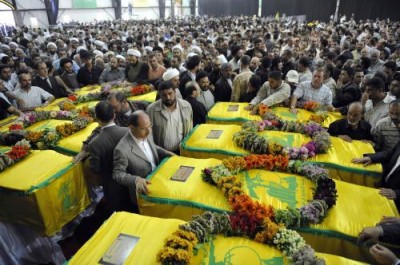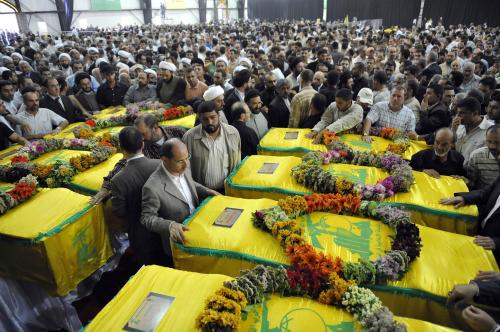
Iran has been recruiting thousands of Afghan refugees to fight in Syria, offering $500 a month and Iranian residency to help the Assad regime beat back rebel forces, according to Afghans and Western officials.
The Iranian Revolutionary Guard Corps, or IRGC, recruits and trains Shiite militias to fight in Syria. Details of their recruitment efforts were posted this week on a blog focused on Afghan refugees in Iran and confirmed by the office of Grand Ayatollah Mohaghegh Kabuli, an Afghan religious leader in the Iranian holy city of Qom. A member of the IRGC also confirmed the details.
“They [IRGC] find a connection to the refugee community and work on convincing our youth to go and fight in Syria,” said the office administrator of Ayatollah Kabuli, reached by telephone in Qom. “They give them everything from salary to residency.” Iran is offering the refugees school registration for their children and charity cards in addition to the $500 stipend and residency.
Many Afghan young men have written to Ayatollah Kabuli to ask whether fighting in Syria was religiously sanctioned, his office said. He responded only if they were defending Shiite shrines. Lately, his office said he has kept silent and not even attended funerals of Afghans killed in Syria.
On Thursday, a large funeral procession attended by local and religious officials was held in the northwestern city of Mashhad, near the Afghan border, for four Afghan refugees killed in Syria. The coffins were shrouded in green cloth and the men’s pictures were pinned to the sides, according to reports on Shiite religious websites and a news agency linked to the Revolutionary Guards.
Reports of funerals for the Afghan recruits who die in Syria began to emerge in November. Recently, there have been more frequent reports of such deaths popping up in Iranian media
Hamid Babaei, a spokesman for the U.N. mission to Iran, said allegations that Iran is sending Afghan refugees to Syria as fighters are unfounded.
“Iranian presence in the country is solely advisory in nature in order to help counter the extremist… al-Qaeda groups from committing more massacre and bloodshed,” he said.
Since the conflict started in Syria three years ago, the Islamic Republic has played an instrumental role in keeping President Bashar al-Assad in power. Iran has funded, trained, armed and sent foot soldiers and commanders to Syria to assist Mr. Assad’s army.
Its close ally Hezbollah, the Lebanese Shiite militant and political group, has also sent soldiers and commanders to defend Syria’s regime.
The Revolutionary Guards organize and command the Shiite militias sent to Syria.
Commanders work closely with Syrian army commanders to plan strategy and train Syrian soldiers in guerrilla warfare, according to Guards commanders.
As a result, in less than a year Mr. Assad has gone from being at the brink of collapse at the time of the chemical attacks against opposition strongholds last August to planning another four years in office with elections set for June.
Both Iran and Hezbollah have openly taken credit for their efforts in Syria. Gen. Hossein Hamedani, a senior Guards commander involved in planning war strategy in Syria, said last week that with God’s help, Iran had trained an extra 130,000 soldiers ready for dispatch.
Thanks to the planning and wisdom of Iran’s leaders, Syria’s regime could enjoy “some stability,” he said.
The 130,000 was an apparent reference to all the Shiite militias including Iranians, Hezbollah, Afghans and other foreign fighters.
Iran also took credit for the recent peace deal between opposition rebels and the regime in Homs, whereby the rebels evacuated the city and surrendered control to the government.
“Nothing happens in Syria without Iran’s hand,” said Hossein Sheikholeslam, a lawmaker and parliament’s deputy head of foreign affairs.
Syria’s civil war shows no sign of subsiding and both Iran and Hezbollah are wary of losing their trained men on the ground and the risk of public backlash with dead bodies returning home every week.
A Western official in Iran said recruiting Afghans was part of a shifting strategy to send poor foot soldiers to the front lines from a community with little clout to minimize casualties among Hezbollah and Guards members and political fallout.
The Afghan recruits, like Hezbollah and most Iranians, are all Shiites and support the Syrian regime dominated by minority Alawites, an offshoot of Shiite Islam.
The rebels are predominantly Sunni and backed by the Sunni powers of the Middle East, such as Saudi Arabia and Qatar.
The Guards are convincing Afghans to join the war in Syria by playing off Shiite-Sunni sectarian rivalries.
They emphasize the role of hard-line Sunni rebel groups affiliated to al Qaeda, said the Western official.
“Iran wants to play a command and control role in Syria and with the Afghan refugees, they are purchasing mercenaries to do the fighting for them,” said Nader Hashemi, director of the center for Middle East Studies at University of Denver, and an expert on Iran and Syria.
U.S. defense officials in Washington have noted with alarm that fighters from around the region have become involved in Syrian civil war, and don’t doubt that Afghan fighters have joined in.
“One of the most concerning aspects of the Syrian conflict from a U.S. security perspective is that it is attracting foreign fighters from across the region and around the world,” Matthew Spence, a senior defense official, told Congress recently.
“We assess that there are now significantly more foreign fighters in Syria than there were foreign fighters in Iraq at the height of the Iraq war,” he said, referring to both sides in the civil war.
Afghan refugees are among the most vulnerable and poor in Iran.
There are about one million registered Afghan refugees in Iran, according to the U.N. refugee agency.
But additionally, there are as many as 2 million unregistered migrants, according to Human Rights Watch. Up to 800 Afghans try to cross illegally into Iran every day, according to Afghanistan’s refugee ministry.
They are not allowed to officially work, attend school or register marriages or births.
Most Afghans work as day laborers in construction for meager salaries.
Reza Ismaeli was a 19-year-old Afghan refugee living in Mashhad. He was a state champion in bodybuilding before he was recruited to fight in Syria, according to an account of a friend and fellow Afghan fighter published in December by the Fars news agency, which is linked to the Revolutionary Guards.
After a few months of fighting in Syria, he became one of the leaders of the all-Afghan battalion calledFatemiyoun, named for the Prophet Muhammad’s daughter Fatima. Iranian news reports say Fatemiyoun battalion is in Syria to defend the Shiite shrine of Sayeda Zeinab in the suburbs of Damascus.
Mr. Ismaeli was killed in December, according to Fars, in a battle with opposition rebels near Damascus. “The battle was very intense. We only had a few hours of cease fire every few days,” an Afghan refugee fighter named Abu Heydar told Fars. Mr. Ismaeili was captured by rebels and beheaded, the report said.
A series of pictures of Mr. Ismaeili on Fars show a short, baby-faced teenager in military fatigues and dark sunglasses posing with a machine gun in front of a tank and then next to a missile stuck in the ground. And then his decapitated bloody head held by a rebel soldier. The Iranian battalion found his headless body and sent it back to his parents in Iran, Fars said.
In a blog dedicated to issues of Afghan refugees in Iran, young Afghan men debate whether they should go to Syria.
“Why is Syria our business? We don’t have peace in our own country and we have to go become martyrs for Iran’s holy war?” wrote one.
WSJ


Leave a Reply
You must be logged in to post a comment.